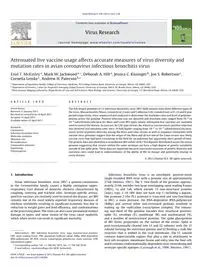
2011 Attenuated live vaccine usage affects accurate measures of virus diversity and mutation rates in avian coronavirus PDF
Preview 2011 Attenuated live vaccine usage affects accurate measures of virus diversity and mutation rates in avian coronavirus
Virus Research 158 (2011) 225–234 Contents lists available at ScienceDirect Virus Research journal homepage: www.elsevier.com/locate/virusres Attenuated live vaccine usage affects accurate measures of virus diversity and mutation rates in avian coronavirus infectious bronchitis virus Enid T. McKinley a, Mark W. Jackwood a,∗, Deborah A. Hilt a, Jessica C. Kissinger b, Jon S. Robertson c, Cornelia Lemke c, Andrew H. Paterson b,c a Department of Population Health, College of Veterinary Medicine, 953 College Station Road, University of Georgia, Athens, GA 30602, USA b Department of Genetics, Center for Tropical & Emerging Global Diseases, University of Georgia, 500 D. W. Brooks Drive, Athens, GA 30602, USA c Plant Genome Mapping Laboratory, Departments of Crop and Soil Sciences, Plant Biology, and Genetics, University of Georgia, 111 Riverbend Road, Athens, GA 30602, USA a r t i c l e i n f o Article history: Received 11 January 2011 Received in revised form 14 April 2011 Accepted 15 April 2011 Available online 22 April 2011 Keywords: Coronavirus Infectious bronchitis virus Molecular evolution Mutation rate Recombination Comparative genomics Sequencing Polymorphism a b s t r a c t The full-length genomes of 11 infectious bronchitis virus (IBV) field isolates from three different types of the virus; Massachusetts (Mass), Connecticut (Conn) and California (CAL) isolated over a 41, 25 and 8 year period respectively, were sequenced and analyzed to determine the mutation rates and level of polymor- phisms across the genome. Positive selection was not detected and mutation rates ranged from 10−4 to 10−6 substitutions/site/year for Mass and Conn IBV types where attenuated live vaccines are routinely used to control the disease. In contrast, for CAL type viruses, for which no vaccine exists, positive selection was detected and mutation rates were 10 fold higher ranging from 10−2 to 10−3 substitutions/site/year. Lower levels of genetic diversity among the Mass and Conn viruses as well as sequence similarities with vaccine virus genomes suggest that the origin of the Mass and all but one of the Conn viruses was likely vaccine virus that had been circulating in the field for an unknown but apparently short period of time. The genetic data also identified a recombinant IBV isolate with 7 breakpoints distributed across the entire genome suggesting that viruses within the same serotype can have a high degree of genetic variability outside of the spike gene. These data are important because inaccurate measures of genetic diversity and mutation rates could lead to underestimates of the ability of IBV to change and potentially emerge to cause disease. © 2011 Elsevier B.V. All rights reserved. 1. Introduction Avian infectious bronchitis virus (IBV) a gamma-coronavirus in the Coronaviridae family causes a highly contagious upper- respiratory tract disease of domestic chickens characterized by coughing, sneezing and tracheal rales. Serotype-specific attenu- ated live vaccines are routinely used to control the disease, yet IBV remains one of the most widely reported respiratory diseases of chickens worldwide resulting in significant economic loss due to reduction in weight gains and feed efficiency, and condemnations at the processing plant. The virus can also cause permanent oviduct damage in layers and some strains of the virus cause nephritis, which when severe can result in significant mortality. Abbreviations: IBV, infectious bronchitis virus; nsps, nonstructural proteins; ORF, open reading frame; PBS, phosphate buffered saline; RdRp, RNA-dependent RNA-polymerase; RT-PCR, reverse transcriptase-polymerase chain reaction; UTR, untranslated region. ∗ Corresponding author. Tel.: +1 706 542 5475; fax: +1 706 542 5630. E-mail address:
